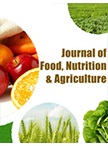Incidence and severity of major diseases of coffee in highland of eastern Ethiopia
DOI:
https://doi.org/10.21839/jfna.2021.v4.6944Keywords:
Coffee berry disease, coffee leaf rust, Eastern Ethiopia, Incidence, SeverityAbstract
This study was conducted with the objective to assess the incidence and severity of coffee berry disease (CBD) and coffee leaf rust (CLR) in the highland of Eastern Ethiopia. In the east Hararge Zone of Eastern Ethiopia, coffee was grown by 331,651 holders on 7,584 ha with a production output of 3,722 tons and a yield of 0.5 ton/ha in 2017. Bedeno is the leading coffee producer district in the Zone followed by Melka-ballo, Deder and Meta districts. In Bedeno, coffee is mainly grown in altitudes ranging from 1690 to 2260 masl. Coffeeberry disease and leaf rust are the two major diseases of coffee in the area. A total of 34 representative coffee farms at nine study sites (3-4 coffee farms at the interval of 3-5 kilometers) were selected through discussion with Bedeno district’s coffee experts. The study sites were selected using sequential sampling techniques through discussions with the district’s coffee experts. Incidence of coffee berry disease and leaf rust was determined as percentage of diseased trees. Disease severity was determined as percentage of diseased coffee berries per plot. Data were analyzed using descriptive statistics. The result of this study revealed the incidence of CBD in Bedeno district ranged from 30.0 to 93.3% with a mean of 70.19%. The severity of the CBD was from 13.3% to 44.4% with an average severity of 28.53%. Both incidence and severity of CBD were high at Barkalle followed by Barakat and Hindhessa areas. On the other hand, the incidence of coffee leaf rust varied from 18.9 to 87.4% with a mean of 52.7%. The high mean incidence of CLR at highland areas of eastern Ethiopia is clear evidence for the occurrence of climate change in the area. Hence, it is advisable to introduce improved coffee varieties that are resistant to coffee berry disease and leaf rust for production in the area. Training farmers to implement proper cultural disease management practices such as prunning and sucker management will also help alleviate the constraint.
Downloads
References
Arega, Z., Demelash, T., Chala, J., Sisay, T., Mesfin, S., & Girma, A. (2008). Success Stories in Managing Coffee Berry Disease in Ethiopia. In A. Girma, B. Bayetta, S. Tesfaye, T. Endale & K. Taye. (Eds.), Coffee Diversity and Knowledge (pp. 239 – 249). Proceedings of a National Workshop Four Decades of Coffee Research and Development in Ethiopia, 14 –17 August 2007, Addis Ababa, Ethiopia.
Bayeta, B., Labouisse, J. P., Hamelin, C., Kotecha, S., & Bertrand, B. (2007). Collection and ex-situ conservation of coffee landraces in Ethiopia: The example of harerge. In 21st International Conference on Coffee Science, Montpellier (France), 11th to 15th September 2006. ASIC, pp. 926-930.
CSA. (2017). Central Statistical Agency of Ethiopia. Report on Area and Production of major crops in Ethiopia. Annual Agricultural Sample Survey of 2016/17, Statistical Bulletin 584.Volume I. Addis Ababa, Ethiopia. pp.50-53.
Desse N. (2008). Mapping Quality profiles of Ethiopian Coffee by Origin. In Proceeding of a National Workshop Four Decades of Coffee Research and Development in Ethiopia, 14-17 August 2007, Addis Ababa, Ethiopia. pp. 317-327.
Eshetu, D. (1997). Coffee diseases and their significance in Ethiopia. ASIC, 17(I), 723-726.
Eshetu, D. (2000). Control of coffee berry disease by fungicides in Ethiopia. In Proceedings of the workshop on control of coffee berrydisease (CBD) in Ethiopia. 13 – 15 August 1999, Addis Ababa, Ethiopia. pp. 35 – 46.
Eskes, A., & Toma-Braghini, M. (1981). Assessment methods for resistance to coffee leaf rust (Hemileia vastatrix Berk. Et Br.) Plant protection bulletin. FAO 29:56-66. Journal of Plant Diseases and Protection, 108 (2), 136-142.
Girma, A., Challa, J., & Hindrof, H. (2016). Interactions of Coffee Leaf Rust (Hemileia vastatrix) with Its Host Across Production Systems of Ethiopia. The proceeding of 26th International Conference on Coffee Science, November 13-19, Kunming, China, pp. 382.
Hindorf, H. (1975). Colletotrichum occurring on Coffea arabica: A Review. Journal of Advanced Research,5(3), 43-56.
Chala, J., Chemeda, F., Girma, A., & Holger, H. (2010). Coffee Leaf Rust Epidemics (Hemileia vastatrix) in Montane Coffee (Coffea arabica L.) Forests in Southwestern Ethiopia. East African Journal of Sciences, 4, 86-95. https://doi.org/10.4314/eajsci.v4i2.71530
McDonald, J. (1926). A preliminary account of a disease of green coffee berries in Kenya colony. Transactions of the British Mycological Society, 11, 145-154. https://doi.org/10.1016/S0007-1536(26)80033-6
NBE. (2019). National Bank of Ethiopia Annual Report of the year 2017/18, pp. 67-69.
Sylvian, P. G. (1955). Some observatios on Coffea Arabica L. in Ethiopia. Turrialba, 5, 37-53.
Tefesetewold, B. (1995). Studies of Colletotrichum population on Coffea arabica L. In Ethiopia and evaluations of the reactions of coffee germplasm. PhD Dissertation, University of Bonn, Germany. pp. 231.
Tefestewold, B., & Mengistu, H. (1989). Colletotrichum species associated with coffee berry disease in Hararghe. Ethiopian Journal of Agricultural Sciences, 11, 1 – 6.
Van der Graaff, N. A. (1981). Selection of Arabica coffee types resistance to coffee berry disease in Ethiopia. Mededelingen Landbouwhogeschool, Wageningen 81–11, 110.
Workafes, W., & Kassu, K. (2000). Coffee production system in Ethiopia. In Proceedings of the Workshop on Control of Coffee Berry Disease in Ethiopia, 13-15th August, 1999, Addis Ababa, Ethiopa.






 .
.